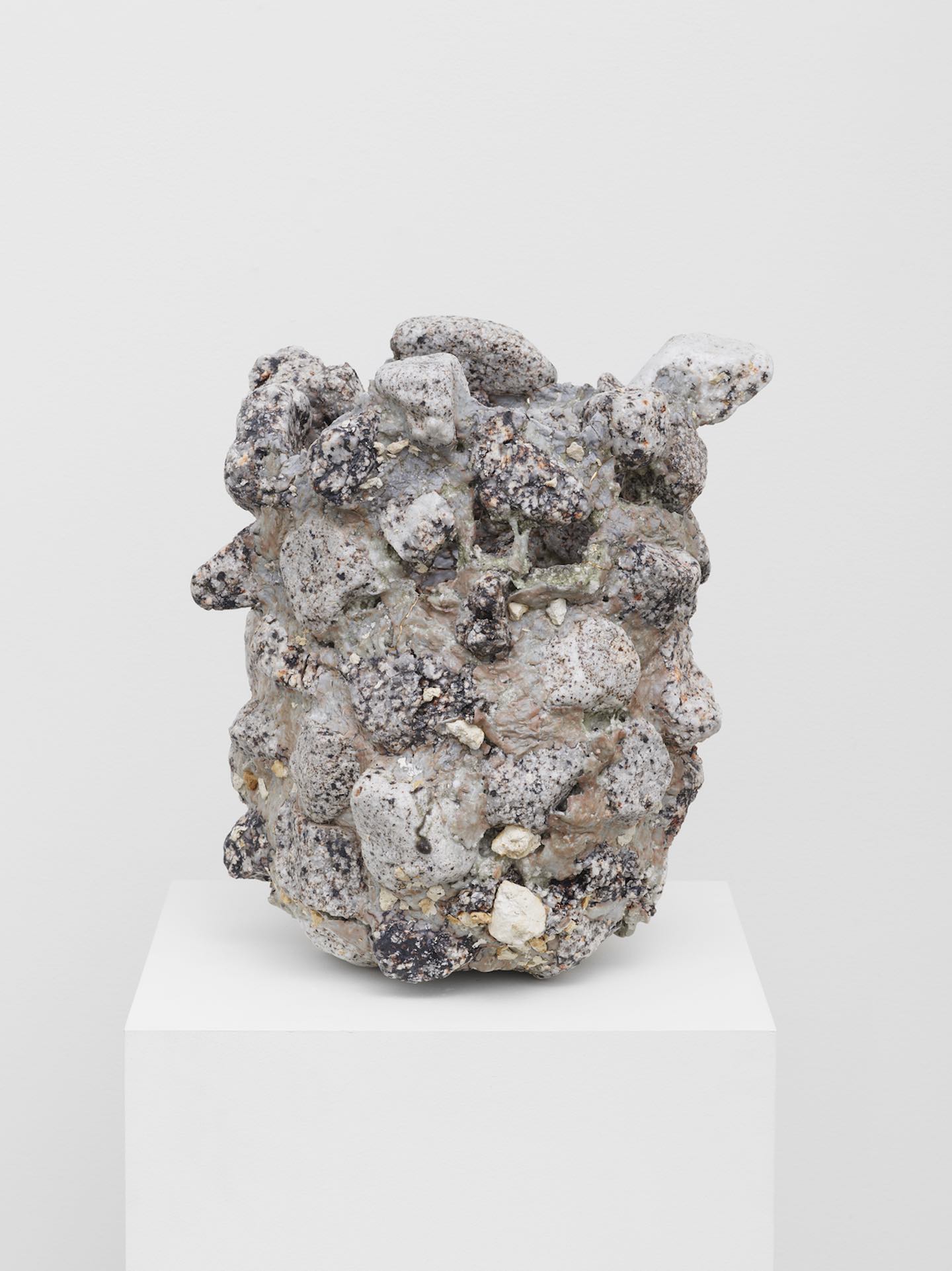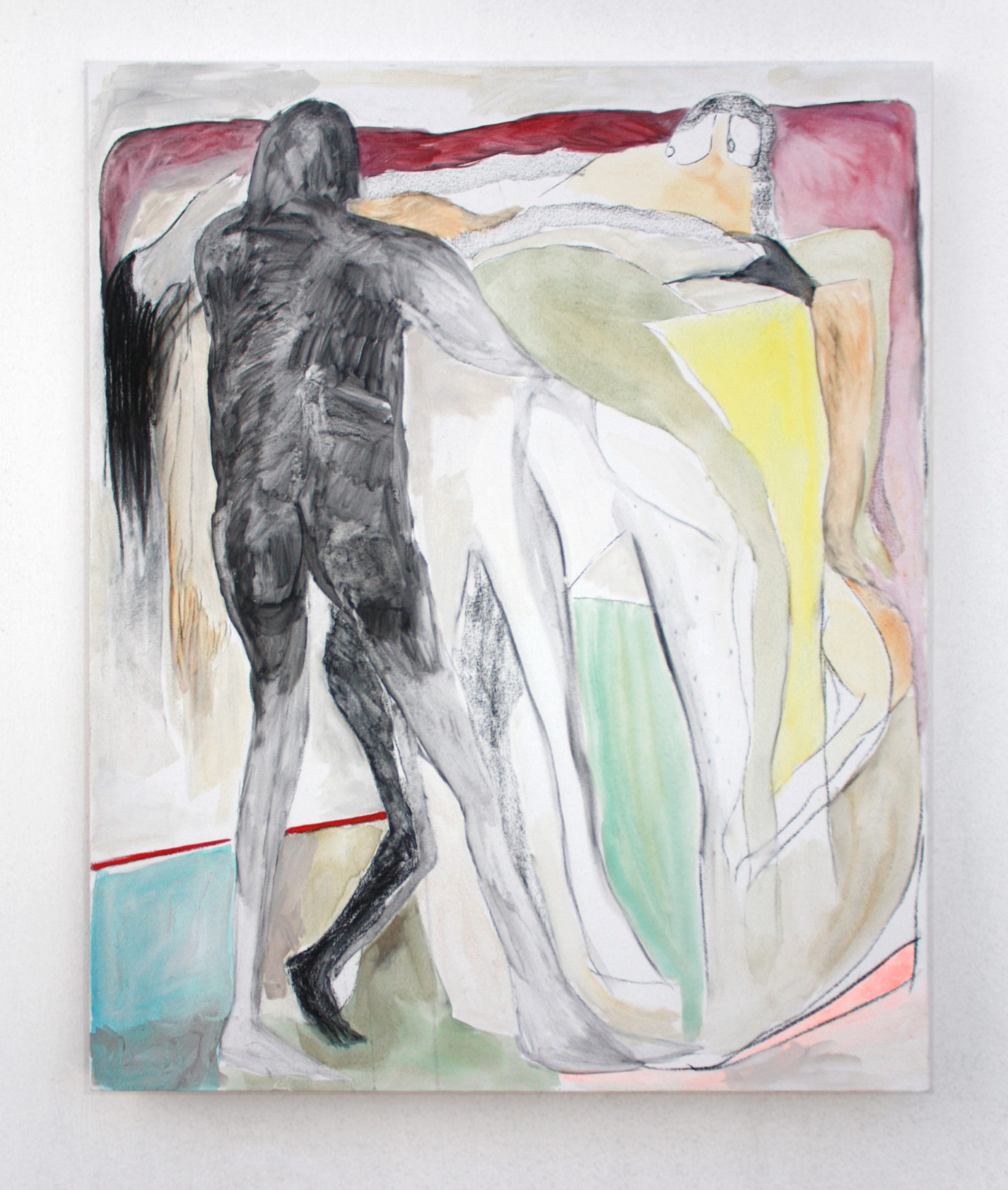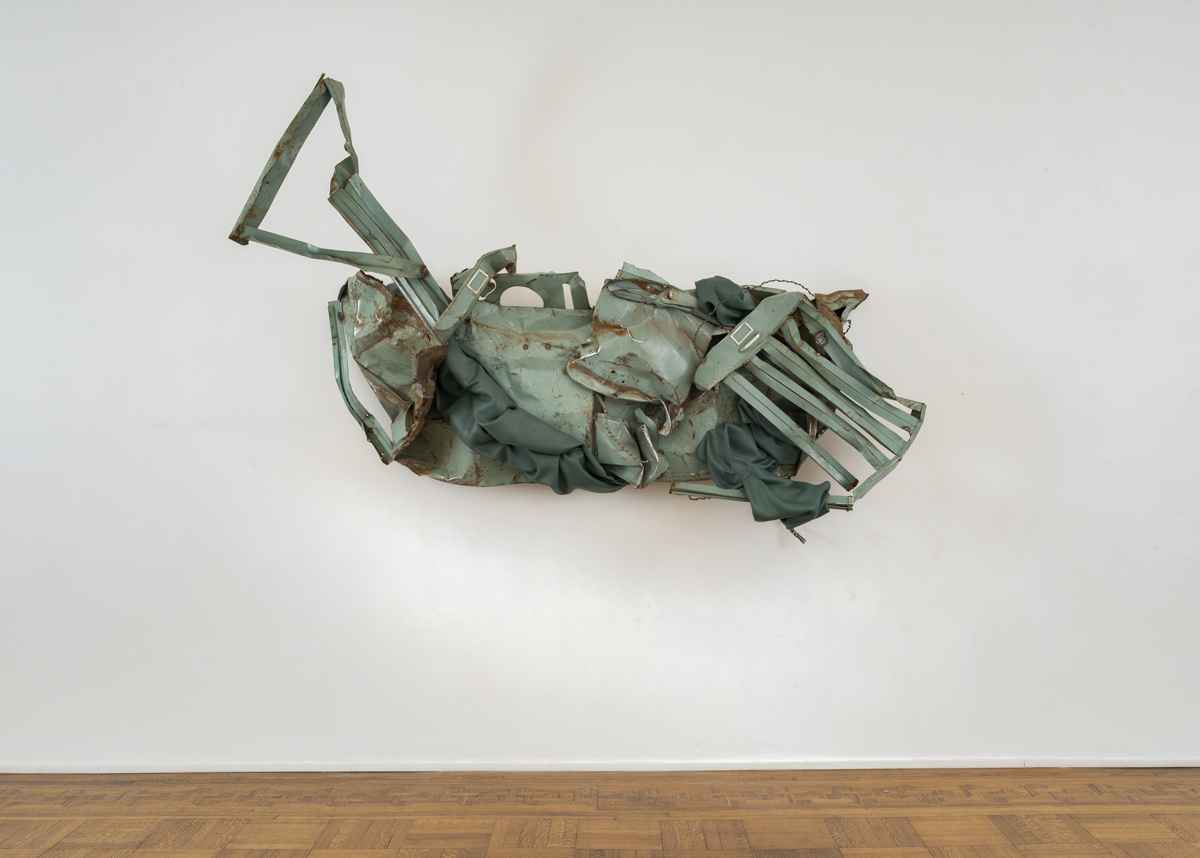Even now that New York galleries are open, and have been for nearly a year after being closed from mid-March through late June in 2020, I haven’t been able to bring myself to frequent them as diligently as I used to. Yes, I go, and gladly, but I’m far more selective about what I see. I mostly walk in where I already have some hope of seeing something that might raise my spirits and skip the ones where I have no inkling of what I’m going to see.
In the long run, that’s no way to practice art criticism, I know. Privileging the already-known, or the already-known-about, has probably deprived me more often than I realize of one of the great (though not so common) pleasures afforded by gallery-going. I’m talking about the pleasure of walking into a space and encountering something quite unfamiliar, unanticipated—and wonderful. It’s what my fellow critic Martin Herbert recently called “that what-the-hell-is-this space of unanswered doubt.” Experiencing that encounter with the unknown is exciting for any art lover, but for the critic on the beat, the excitement is laced with a frisson of anxiety: Will you be up to the challenge of writing about something you had no idea about until just now, something that may not already be surrounded by the penumbra of discourse that surrounds almost all the art one sees, not just the classics enshrined in museums but, for the assiduous gallery visitor, just about everything? Even before you walk through the door, you’re already clued in to how to see the work or, at least, how you are expected to see it. Not that artists don’t pull surprises out of their sleeve or that expectations can’t be overturned—but those are the happy exceptions.
There were no expectations to be overturned when, as I strolled down Orchard Street on the Lower East Side recently and passed a storefront where I didn’t expect to find a gallery at all (there had been one there before, I knew, but it had closed), I noticed that a new gallery had sprung up. And glancing through the front window, I did a double take. Those paintings looked good. I was on my way somewhere else, but I had to walk in.
This turned out to be the new home of Proxyco Gallery, a place specializing in art from Latin America that I had previously visited in its former, smaller quarters further east on Suffolk Street. What had pulled me through the door were paintings in which pale, luminous colors adumbrate distorted, fragmented, ectoplasmic bodies arrayed in closed and yet somehow not claustrophobic environments. The point was clearly not how bodies look, but how it feels to have them, be them—a visual translation of a subjective perception. This, clearly, was the work of a painter with a beautifully light touch yet a blunt approach to drawing, someone adept at registering nuances of sensation without overemphasis—and with a sense of humor!
Popular
"swipe left below to view more authors"Swipe →
In particular, there was something about how this painter found uncommon expressive potential in legs and feet. How else could the artist have eked out some signs of expression, these being more-or-less figurative paintings but without faces; for while hands—the other great instrument of expression in painting—are not entirely absent in them, they are both scarce and rudimentary. A foot is inexpressive compared to a hand, but if forced to convey feeling, there must be something comical about the foot’s expression—an awareness of the appendage’s absurdity, a sense of lowliness and gaucherie. But as it turns out, at least in a context where colors are so sweet, painterly touch so little burdened by the heaviness of the medium, this humor is not derisory but somehow soothing. It takes the weight off the feeling. I noticed that all but one of the paintings had been made this year. In other words, they are products of the Covid-19 era. One pundit has defined “the dominant emotion of 2021” as “languishing,” and there’s a lot of that evoked in these paintings. But the antidote is in the paintings too: the evident joy with which they portray the spirit flagging. And I couldn’t help but reflect on the saving grace of humor as it helps reconcile us to a gloomy situation we somehow have to try to survive.
I learned that this was the work of Lucía Vidales, an artist born in 1986 in Mexico City, living in Monterrey; her show is called “Sudor Frío”—cold sweat. The title implies a sense of threat, of anxiety. Does that mean my perception of humor in the paintings was mistaken? For works such as Off-Centered (2021), which shows a hunched, sitting shape whose arms, head, and one leg seem to have become residual, all its vitality concentrated in the single bent leg and foot with splayed toes, I’ll stick with my idea. Eerier, less funny is Ixiptla (2021), in which a couple of vague figures seem to be bearing away some recumbent (languishing?) others—but the various personages are so entangled that it’s hard to tell how many there are, or which limb belongs to whom. It’s almost oneiric, a phantasmic scene observed coolly even while the goings-on might be fearful, and then afterward remembered only confusedly. I resort to the title for further clarification. It refers to an Aztec concept: the living image of a god. For instance, a person who had been selected as a human sacrifice was, while still alive, treated as a deity; that doomed individual was the god’s ixiptla.
But this ominous vision seemed to reflect the show’s subsidiary mood, not its main one. Ixiptla was the one painting dominated by shades of gray, rather than by prismatic color. More numerous here were works such as Shadow Sign (2021), another image that, like Off-Centered, focuses on a bent leg. Whatever shadows give the painting its title, they are the hot shadows that the early 20th century Fauvist painters used to love. The dominant orange tones seem to be reflected even in the blue of the lower leg—maybe that’s the shadow of the title. This is a painting you could warm your hands by on a cold day. There is some anxiety and depressiveness encoded in Vidales’s canvases, but it’s mostly tempered by a witty self-consciousness and fuel for an infectious ardor.
As everyone knows, the affluent left New York City in droves during the coronavirus pandemic, taking social distancing to an extreme by decamping to vacation homes in the Hudson Valley and Long Island. The art market followed. Manhattan galleries began opening satellites in the Hamptons. For the most part, they seemed to be unimaginatively displaying stock on hand. I remember, last summer, wandering into one of the East Hampton galleries and striking up a conversation with the attendant, who explained to me that the random selection of blue-chip works on hand was the intended contents of the gallery’s booth at that year’s Basel art fair, which had of course been canceled.
When something unusual turns up in a context like that, it stands out. That was the case with an exhibition by Masaomi Yasunaga at the East Hampton outpost of the Lisson Gallery, the venerable London showcase for, mostly, conceptual and minimal art, which opened its New York branch in 2016. I didn’t stumble into this show at random, as with Vidales’s; an image in a press release caught my eye. Far from specializing in either conceptualism or minimalism, this Japanese artist, born in 1982 and living in the Mie prefecture, makes ceramics. But whether this is really the right word for his work is a question I’ll come to shortly. He makes things that are materially overwhelming and rough, though generally modest in scale. (The largest of the pieces on view is about four feet high, but most are much smaller.) Although mostly he uses highly irregular or distorted versions of traditional vessel forms, what’s immediately striking about the pieces I saw are their surfaces: gnarled, lumpy, dense with stones and soil. And then their shapes are extremely varied: Vessels, yes, but to characterize them individually might mean having to resort to far-flung episodes in the history of pottery-making—to speak of jugs, ewers, amphorae, reliquaries, costrels, or who knows what, and to draw comparisons with Greek or Pre-Columbian typologies as much as Asian ones.
Yet, in a sense, Yasunaga is a sort of minimalist. What he has minimized is precisely the traditional material of his craft, the very thing that normally defines it. His “ceramics” are created without clay. Instead, he employs glaze—the glassy substance normally used as an external coating to decorate and waterproof a ceramic object—as his primary medium.
In fact, many of Yasunaga’s objects look more like they’re made of unusually coarse concrete than anything else. I don’t really understand how he manages to coax a material that’s normally not self-supporting to hold these agglomerations together and function as the structural basis of his forms. The gallery press release explains it this way: “Combined with unique raw materials such as feldspars, whole rocks, metal or glass powders, Yasunaga’s forms are buried in various strata of sand or kaolin (unrefined porcelain clay) to preserve their structure in the firing stage. After cooling, Yasunaga’s sculptures are excavated from their beds in a studio process analogous to archaeological excavation and discovery.” In any case, the resulting objects don’t look quite like anything I’ve seen before. But the gallery’s evocation of archaeological finds is apt; encrusted as they are with pebbles and sand, one might well imagine that these objects had been dredged up from some ancient burial site where they have lain for eons, their forms distorted by the pressure of the earth’s weight as they’ve accreted all sorts of mineral substances foreign to their original makeup.
Looking at these rugged, powerful, encrusted forms that allude to familiar everyday functional objects despite seeming so alien, I couldn’t help thinking of Sigmund Freud’s recurrent comparison of his patients’ psychoanalytic quarrying of memories to an archaeological excavation, an analogy he always kept at the forefront of both his own and his patients’ awareness by turning his consulting room into a sort of miniature archaeological museum stuffed with antiquities. As one commentator on this side of Freud’s thinking has observed, the upshot is that “the repressed memories brought back to life and…pictures and relics of one’s past…are kept as museum pieces—carefully put out of the way from everyday business, but near enough for contemplation and further study.” Yasunaga’s works likewise seem to be about the structure of memory—how it transforms things in the process of preserving them.
In the gallery, many of the pieces are arrayed on beds of gravel. At times the presentation is unfortunate—more space would make it easier to appreciate each one individually. But seeing them as an ensemble brings out another possibility: One can easily imagine the forms crumbling and merging with the loose aggregate. In that sense they are ambiguous. To think of them as artifacts unearthed after a long sleep in the earth is to imagine a kind of resurrection, a rediscovery that brings ancient things new life, but also evokes death and dissolution. Far from being a contradiction, this duality is what, beyond their novelty in process and appearance, gives Yasunaga’s works their poignancy and power.
Another sculptor who does unexpected things with materials is Kennedy Yanko, an American born in St. Louis in 1988 and now living in Brooklyn. But her inventiveness may not be apparent at first glance—although it took only a couple of images of Yanko’s work, posted on Instagram by an acquaintance (with no commentary, just the name of the artist and gallery), to make me head over to her exhibition “Postcapitalist Desire,” at the Tilton Gallery on Manhattan’s Upper East Side. The six works in the show are assemblages, mostly wall-mounted rather than freestanding, featuring salvaged and reworked scrap metal—twisted, crushed, and crumpled forms that might remind you of, for instance, the sculptures made of smashed car parts for which John Chamberlain became famous in the 1960s, or of the found-object assemblages of John Outterbridge, the remarkable and still underknown Los Angeles–based African American artist, who passed away last year. “In castoffs there are profound treasures,” said Outterbridge, who also exhibited at the Tilton Gallery—and he proved it.
Yanko, too, has an eye for the hidden potential of what others have discarded. For her, this potential seems to lie mainly in abstraction, in the physical qualities of the materials she uses rather than in allusions to those materials’ past lives in the utilitarian realm. While someone more familiar with the affordances of scrapyards may be better able to divine what functions Yanko’s painted metal finds once may have had, I’m mostly at a loss—the one exception being the work titled The Politics of Wholeness (2021), where even I can make out that these used to be storage drawers, thanks to the telltale label holders. More to the point, though, is the utter transformation the metal has undergone at the artist’s hands: Liberated from the rectilinear geometry that once defined it, and even from the sense of implacable obduracy that’s unavoidable with a piece of steel office furniture, it’s become something like a dynamic cloud of dusty, rusty turquoise floating across the wall. Its literal hardness has been made to convey something paradoxically fluid and almost intangible, yet without disguising what the material really is.
Other pieces leave me wondering: What, for instance, was the original use of that metal perforated with small holes in Released from the wire and Making Light (both 2020)—assuming (which maybe I shouldn’t) that Yanko herself did not add them? But more often, the material just seems so generically “scrap metal” that I don’t think about its previous identity. I accept its present sculptural form as a given but—with that title Making Light in mind, perhaps—remain amazed that these complexly involuted or billowing forms bespeak such effortless plasticity. And then there’s Yanko’s very precise eye for color: Shades such as the butterscotch yellow of Making Light, or the hue somewhere, I think, between teal and ruddy blue in Pleasure Page (2021), feel very deliberate, carefully seen, not merely found and serviceable.
As my reference to Chamberlain implies, Yanko’s use of scrap metal represents a personal take on a familiar formal idiom. But metal is not the only material she’s used in these pieces. In all of them, the metal is in dialogue with something else I couldn’t identify at first. I wondered if it was PVC; anyway, it takes the form of a thick, dense fabric-like substance, scrunched up or hanging freely. Physically it is evidently more pliable, more amenable to the sculptor’s manipulations. Also notable is the opacity of its coloring—not a surface layer, like paint on metal (or for that matter, the glaze on a piece of ceramic), the color of this stuff appears to be tantamount to its substance: color all the way through. Well, no wonder. These turn out to be paint skins, that is, paint that Yanko has poured onto a horizontal surface to set, then worked with before it had completely dried. (But what kind of paint? We are not told.) No wonder I could not identify it—for isn’t the office of paint to represent anything at all (flesh, air, water, light, objects) as much as itself? Paint, I almost want to say, has something in common with what Keats called the poetical character, namely that “it is not itself—it has no self—it is every thing and nothing—It has no character—it enjoys light and shade.” Yanko shows paint as nothing but itself but in doing so displays it precisely in its anonymity, its neutrality, what Keats would have called its negative capability.
In most of the pieces, the metal and the paint skins are of similar but not identical hues, as if maintaining a close dialogue in which they can’t quite agree. So if the yellow metal of Making Light is, as it seems to me, butterscotch, the paint skin that’s pressed back to the wall behind its roughly triangular configuration is more like goldenrod; the blue metal of Pleasure Page is hardly dark, but the paint skin is distinctly lighter—almost powder blue. Only in a couple of cases is the chromatic difference between the two materials more emphatic. In Spilling Legacy (2021) a paint skin whose brownish orange might not be so far from the shade of the metal in Making Light pours down as if from a ewer from a metal bunching of mottled black and carmine.
Using metal in a painterly way as much as she uses paint sculpturally, Yanko plays with paradox in a marvelously relaxed way, without making a big issue of it or playing a by-now overfamiliar guessing game about the blurred boundaries between the two modes of art-making (this work may be painterly but it is emphatically sculpture). In three of the six pieces, she also introduces an element of drawing by using painted wire. In Pleasure Page and Released from the wire, the colored cords pretend to hold the sculptures in place, as though they might otherwise float away.
Well, floating away is what I felt like after spending time with these sculptures. Like Vidales’s paintings and Yasunaga’s not-so-ceramic ceramics, they reintroduced me to the joy of seeing new and unanticipated beauty—the thing that got me hooked on art in the first place. In that sense, these exhibitions that took me to strange places had also welcomed me home.





